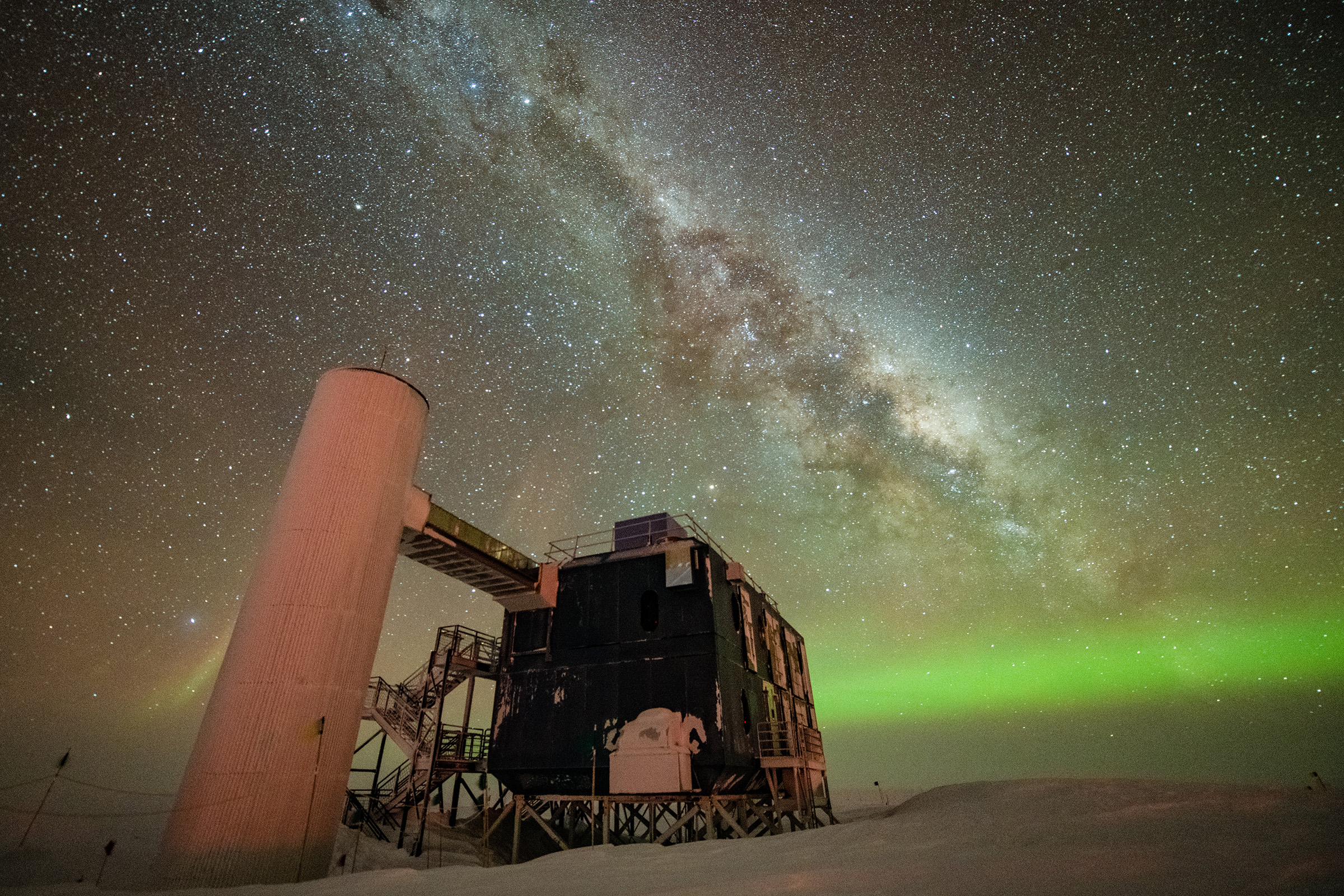Federal physics advisory panel recommends funding next generation IceCube observatory, other major experiments

A view of the IceCube Lab with a starry night sky showing the Milky Way and green auroras. Photo By: Yuya Makino, IceCube/NSF
A group of scientists tasked with advising the federal government’s investments in particle physics research is recommending that the United States fund a planned expansion of the IceCube Neutrino Observatory, an international scientific collaboration operated by the University of Wisconsin–Madison at the South Pole.
The recommendation from the Particle Physics Project Prioritization Panel, or P5, joins other major research priorities in the field. They include support for a separate neutrino experiment based in Illinois; continuing investment in the Large Hadron Collider in Switzerland, the Rubin Observatory in Chile and the global Cherenkov Telescope Array; and development of a next generation of ground-based telescopes to observe the cosmic microwave background.
UW–Madison physicists have leading roles in the Illinois project, called the Deep Underground Neutrino Experiment, along with multiple Large Hadron Collider projects, Rubin Observatory and Cherenkov Array. The recommendations are included in a draft report published Dec. 7.
The P5 advisors include theoretical and experimental physics researchers from institutions around the U.S. Among them are two UW–Madison faculty members: physics professors Tulika Bose and Kyle Cranmer. Cranmer is also director of the UW–Madison Data Science Institute.

Tulika Bose
Bose, Cranmer and their P5 colleagues spent much of the past year assessing the future of particle physics — a field known for massive and expensive international experiments aimed at fundamental questions about the universe — and then developing a list of projects to recommend for U.S. funding.
Bose is an experimentalist who works on the Compact Muon Solenoid experiment at the Large Hadron Collider. Her research is centered on understanding properties of the Higgs boson, a subatomic particle that was first detected a decade ago, along with trying to discover new particles and figure out what is responsible for dark matter.
Cranmer’s early research was focused on searching for the Higgs particle and for signs of new physics; that work was based in the other big, multipurpose experiment at the Large Hadron Collider called ATLAS. More recently, Cranmer has focused on the use of machine learning and artificial intelligence.
The P5 panel’s deliberations come at a time when the field of high-energy physics is at a crossroads of sorts, where a finite pool of funding, international geopolitics and long timescales of experiments with massive price tags all pose challenges that the panel had to consider.

Kyle Cranmer
“Honestly, it was a daunting task,” says Cranmer. “The field is overflowing with good ideas that will produce good science. I wish we could do more, but the proposals that we put forward with a limited budget are compelling.”
In addition to supporting a handful of major experiments, including a next-generation IceCube, the panel is recommending that the U.S. improve the funding balance between projects of all sizes; support a more aggressive research and development program that could yield a “revolutionary” particle accelerator; and invest in developing and broadening the nation’s advanced technology workforce.
“I am excited by the bold long-term vision that is presented in the P5 report,” says Bose, noting particular enthusiasm for the recommendation to speed R&D efforts toward a new particle accelerator, or collider, that could potentially be sited in the U.S.
“Such a collider would be an unparalleled global facility that will provide new insights into the mysteries of our quantum universe,” Bose says.
More immediately, the panel’s recommendations seek to maximize the impact of a limited pool of federal funding over the coming decade. That’s one reason the IceCube expansion, dubbed IceCube-Gen2, is attractive. Upgrading the current observatory would be a relatively cost-effective way to vastly improve the scientific community’s ability to detect and analyze neutrinos, the nearly massless subatomic high-energy particles that provide information about astrophysical phenomena like exploding stars, gamma-ray bursts, black holes and neutron stars.
“Using new technology and taking advantage of the brilliant ice that we can model with ever higher precision, IceCube-Gen2 can expand the detection volume by a factor of eight for a cost comparable to IceCube,” says Albrecht Karle, a UW–Madison physics professor who is leading the IceCube upgrade.
The P5 panel’s recommendations now go to the High Energy Physics Advisory Panel, which helps set funding priorities for the National Science Foundation and U.S. Department of Energy. HEPAP is scheduled to meet and possibly endorse the recommendations on Dec. 8.
Tags: astrophysics, IceCube, physics




